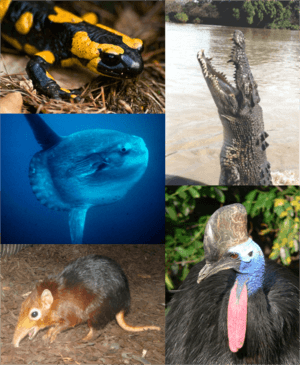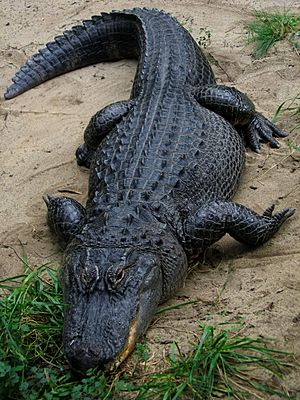Vertebrate facts for kids
Quick facts for kids Vertebrata |
|
|---|---|
 |
|
| Examples from each major vertebrate group: clockwise, starting from top left:
Fire salamander (Amphibia), saltwater crocodile (Reptilia), southern cassowary (Aves), shrew (Mammalia), ocean sunfish (Osteichthyes) |
|
| Scientific classification |
|
| Kingdom: | Animalia |
| Phylum: | Chordata |
| Clade: | Olfactores |
| Subphylum: | Vertebrata J-B. Lamarck, 1801 |

A vertebrate is an animal that has a spinal cord protected by a backbone. This backbone is made of cartilage or bone. The word "vertebrate" comes from "vertebrae," which are the small bones that form the spine. Animals without a backbone are called invertebrates.
Vertebrates include many different kinds of animals. Some common examples are birds, fish, amphibians, reptiles, and mammals. There are tens of thousands of different vertebrate species known today. For example, the term "fish" actually describes at least four different types of vertebrates!
Contents
What Makes a Vertebrate?
Vertebrates all share a few key body parts that make them special:
- Braincase: Also called a cranium, this bony box protects the brain.
- Vertebrae: These are a series of short, strong bones that make up the backbone. They are connected by joints, which allow the backbone to bend. The backbone protects the spinal cord, which carries messages between the brain and the rest of the body.
- Bones: Besides the backbone, other bones support and protect the body's soft parts. They also provide places for muscles to attach, helping the animal move.
- Gill arches: In fish and some amphibians, these structures in the throat (called the pharynx) support the gills. Gills help these animals breathe underwater. In many other vertebrates, some of these arches have changed over time to become other important parts, like jaws.
Why are Vertebrates Important?
Vertebrates are found in almost every environment on Earth. They include the largest animals in most major ecosystems, like whales in the ocean or elephants on land. However, they are not the largest living things overall, as giant trees are bigger!
Vertebrates are also unique because they have an adaptive immune system. This special system helps their bodies fight off sickness and infections. Scientists think this strong immune system might be one reason why vertebrates have been so successful.
Types of Vertebrates
Scientists group vertebrates into different categories based on their features. Here are some of the main groups:
- Jawless Vertebrates (Agnatha): These are the most ancient vertebrates. They don't have jaws.
- Jawed Vertebrates (Gnathostomata): Most vertebrates today have jaws.
- Cartilaginous Fish (Chondrichthyes): These fish have skeletons made of cartilage, not bone. Examples include sharks and rays.
- Bony Fish (Osteichthyes): These fish have skeletons made of bone. This group includes most fish you know.
- Ray-finned fish (like tuna and salmon)
- Lobe-finned fish (like coelacanths and lungfish)
- Four-Limbed Vertebrates (Tetrapoda): These are vertebrates that typically have four limbs.
- Amphibians: Animals like frogs, salamanders, and newts. They often live part of their lives in water and part on land.
- Amniotes (Amniota): These animals lay eggs with a special membrane (or have live births) that protects the embryo.
- Sauropsids (Reptiles and Birds):
- Lizards, snakes, and tuataras
- Turtles
- Archosaurs: This group includes crocodilians (like alligators and crocodiles) and dinosaurs.
- Sauropsids (Reptiles and Birds):
* Birds are living dinosaurs!
-
-
- Synapsids (Mammals):
- Mammals, like humans, dogs, and whales. They usually have fur or hair and feed their young milk.
- Synapsids (Mammals):
-
Related pages
| Vertebrates |
|---|
| Amphibian • Bird • Fish • Mammal • Reptile |
Images for kids
-
Fossilized skeleton of a Diplodocus carnegii, showing the long backbone that all vertebrates have.
-
Gill arches holding gills in a northern pike.
-
The early vertebrate Haikouichthys.
-
Acanthostega, an early four-limbed vertebrate that lived in water.
See also
 In Spanish: Vertebrata para niños
In Spanish: Vertebrata para niños



